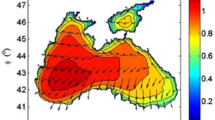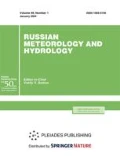Abstract
A high-precision digital elevation model of the Caspian Sea with the spatial resolution of 0.001° x 0.001° is constructed and used as a basis for computation grids of various scales. A three-level scheme for calculating wind waves with the sequence of nested grids (Caspian Sea-Northern Caspian, Absheron Peninsula, Turkmenbashy city-the Northern Caspian key areas) is developed. A scenario designer is implemented which considers in calculations the ice edge position and the coastline dynamics. The SWAN spectral wave model is adapted to the Caspian Sea conditions. The series of calculations and the comparison of the obtained results with observational data are provided. It is found that the best result is obtained when corrected reanalysis data are used for calculations.
Similar content being viewed by others

References
S. A. Ambrosimov and E. S. Ambrosimov, “Experimental Studies of Wind Waves in the Central Part of the Caspian Sea,” Inzhenernaya Fizika, No. 6 (2007) [in Russian].
A. V. Bukhanovskii, S. V. Ivanov, and L. I. Lopatukhin, “Approaches, Experience, and Some Results of Investigation of Ocean and Sea Wind Wave Climate,” Vestnik Sankt-Peterburgskogo Universiteta, Ser. 7, Geologiya. Geografiya, No. 3 (2005) [in Russian].
A. V. Bukhanovskii, L. I. Lopatukhin, and E. S. Chernysheva, “A New Generation of Guidebooks on Sea Waves,” in Research and Development Collected Papers of the Russian Maritime Register of Shipping, No. 34 (2011) [in Russian].
A. V. Bukhanovskii, L. I. Lopatukhin, E. S. Chernysheva, and A. M. Kolesov, “A Storm in the Black Sea on November 11, 2007 and the Statistics of Extreme Storms,” Izv. Russkogo Geograficheskogo Obshchestva, No. 2 (2009) [in Russian].
Water Balance and Sea Level Oscillations of the Caspian Sea. Modeling and Forecasting (Triada Ltd, Moscow, 2016) [in Russian].
L. I. Lopatukhin, Wind Waves. Training Manual, 2nd enhanced ed. (St. Petersburg State Univ., St. Petersburg, 2012) [in Russian].
L. I. Lopatukhin, A. V. Bukhanovskii, A. B. Degtyarev, and V. A. Rozhkov, Reference Data on Wind and Waves for the Barents, Okhotsk, and Caspian Seas (Rossiiskii Morskoi Registr Sudokhodstva, St. Petersburg, 2003) [in Russian].
A. A. Magaeva, N. A. Yaitskaya, N. V. Likhtanskaya, and L. V. Dashkevich, “Development of the Geoinformation System for Ice Regime of the Southern Seas of Russia,” in Ecology, Economy, and Informatics, Vol. 3 (2015) [in Russian].
D. A. Mirzoev, O. I. Zil'bershtein, L. I. Lopatukhin, E. U. Mironov, and N. N. Mikhailov, “The Concept for Provision of the Design of Facilities on the Arctic Sea Shelf with Specialized Hydrometeorological Information,” in Proceedings of the Fourth International Conference “Arctic Sea Shelf Development. RAO-99,” Part 1 (St. Petersburg, 1999) [in Russian].
N. A. Yaitskaya, Thermohaline Regime of the Caspian Sea in Case of Sea Level Variations, Abstracts of Candidate's Thesis in Geography (Murmansk, 2012) [in Russian].
N. A. Yaitskaya and V. V. Loshchinskaya, “Development of the Geoinformation System ofthe Southern Seas of Russia for Preservation of Historical Cartographic Information,” in Ecology, Economy, and Informatics, Vol. 2 (2013) [in Russian].
S. Berdnikov, N. Yaitskaya, and Yu. Lychagina, “The Study of Ice Conditions of the Caspian Sea Using Satellite Momtoring Data (2008-2011),” in Proceedings of the Fourth International Conference on Environmental Management, Engineering, Planning and Economics (CEMEPE 2013) and SECOTOX Conference (2013).
E. Kalnay, M. Kanamitsu, R. Kistler, W. Collins, D. Deaven, L. Gandin, M. Iredell, S. Saha, G. White, J. Woollen, Y. Zhu, M. Chelliah, W. Ebisuzaki, W. Higgins, J. Janowiak, K. C. Mo, C. Ropelewski, J. Wang, A. Leetmaa, R. Reynolds, R. Jenne, and D. Joseph, “The NCEP/NCAR 40-year Reanalysis Project,” Bull. Amer. Meteorol. Soc., 77 (1996).
SWAN. Technical Documentation (DelftUniv. Technology, Faculty ofCivil Eng. and Geosciences, Environmental Fluid Mechanics Section, 2006).
N. Yaitskaya, Y. Lychagina, and S. Berdnikov, “The Ice Conditions Study of the Caspian Sea during the Winter Periods 2008-2010 Using Satellite Monitoring Data and Geographic Information System,” Fresenius Environ. Bull., No. 11, 23 (2014).
Author information
Authors and Affiliations
Corresponding author
Additional information
Original Russian Text © L.I. Lopatukhin, N.A. Yaitskaya, 2018, published in Meteorologiya i Gidrologiya, 2018, No. 4, pp. 54-61.
About this article
Cite this article
Lopatukhin, L.I., Yaitskaya, N.A. Peculiarities of the Approach to Calculation of Wind Waves in the Caspian Sea. Russ. Meteorol. Hydrol. 43, 245–250 (2018). https://doi.org/10.3103/S1068373918040052
Received:
Accepted:
Published:
Issue Date:
DOI: https://doi.org/10.3103/S1068373918040052



